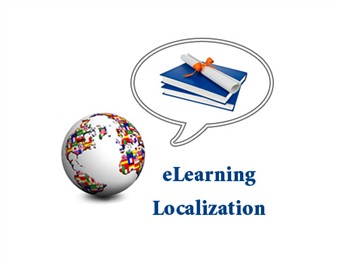eLearning Localization: Localizing for Multiple Cultures/Countries
In our previous blog eLearning Localization: Multicultural or Multiple Cultures?, we talked about how we can localize your elearning courses to suit the needs of a multicultural workforce. Remember these two figures?
|
|
 |
Figure 1 represented a U.S. organization with a multicultural workforce, in which we assumed that your targeted learners are primarily second generation or later Americans (the black dots), but with several first generation cultural groups represented (colored circles), as well. This indicates that, while they are different, they have certain characteristics in common. In addition, they were all U.S. residents and, therefore, are constantly exposed to American culture. Thus, one approach to addressing cultural differences was to identify overlapping similarities and localize your course to address commonalities.
Figure 2 represented a U.S. organization that has business affairs in other countries. In this situation, you would typically regard the U.S. learners as a homogenous cultural group. In contrast to the approach described above, you would now need to modify the U.S.-designed course to accommodate learners in each of the targeted countries. Typically, you do this by first removing “Americanisms” (think of it as applying a ‘primer coat of paint’). Then, you would localizeversions of the course for each distinct culture or cultural group (think of it as applying different colored paints). Let’s look at an example to illustrate how to localize for multiple cultural groups.
Applying the Primer Coat of Paint
As we’ve mentioned in previous blogs, we typically adapt elearning courses by analyzing content, instructional approach, and course technology/media to determine (a) how each aligns to learners’ preferences and expectations, and (b) how we can make adaptations that are critical to the achievement of equitable learning outcomes.
But, how do we do this for multiple countries? Furthermore, how do we do it in an effective manner, minimizing the use of time and resources? The first step is to identify and remove Americanisms, or replace them with locally relevant ones. Let’s look at a few examples.

What to Eliminate or Replace
With respect to content, we localize the language by using Global English. Doing so effectively removes American jargon, colloquialisms, slang, and other forms of language that tend to increase reading time, decrease comprehension, and cause confusion for non-Americans. In addition, using Global English can decrease your translation costs by 30-50% because language is simpler, clearer, and better structured.
Another way to improve learner comprehension – and decrease translation costs – is to create a standardized glossary of terms to be used by anyone in the course production process (content authors, script writers, etc.). A glossary not only creates a common language to be used throughout the course, it also helps to eliminate synonyms. For example, you might decide to always use ‘the company’ instead of ‘the organization’ or ‘the institution.’ Again, this approach improves readability while decreasing the cost of translation!
We also examine multimedia to ensure that images, icons, background scenes, etc. To prepare courses for global audiences, you need to first identify any of these that indicate the course was designed in the U.S. Subsequently, you replace them with images and multimedia (including audio) that represent the targeted learners’ contexts. For example, in the U.S. version of an ethics and compliance course, there is a scene in which a manager is accepting a gift of wine from a vendor. However, if your targeted learners are in a religious country where wine gifts would be uncommon, you would want to replace the images with something more locally relevant. If you have American actor in a video who’s imitating a British accent, you can bet that learners in Great Britain will detect the difference!
The same principles apply to the instructional methods. In the U.S., for example, we are accustomed to being challenged in training courses, by including casestudies that need to be ‘solved.’ However, in many countries, the norm is didactic learning, where the teacher is the expert and simply passes knowledge on to the students via lecture: Problem solving is not an instructional approach. Consider an elearning course about ethical behavior, in which the designers initiated the course by requiring learners to resolve an unethical situation. Once the learners ‘resolve’ the issue, they are given feedback as to why or how their responses were correct or not. However, learners in several countries expressed frustration with this approach because they were not first provided with the content that gave them the answers. In other words, they wanted to receive all of the information necessary to make an informed decision before being tested on their ability to respond tothe situation posed in the case study. In this particular course, simply the content before the case study made the course more acceptable to learners in risk adverse cultures who were accustomed to didactic teaching methods.
How to Do It
However, how can we make such modifications without expending an inordinate amount of time and resources? There are several techniques you can begin using during the instructional design process that will prepare your courses for cultural modification in a way that preserves time and resources.
Templates
First, you can create a template for a course that will be sent to other countries. In fact, this is good ‘best practice’ for any course.
- You design the learner interface with enough space to translate instructions, navigation, etc. without changing page layout.
- Wherever you need to contextualize the content, you leave gaps or blank spaces to insert appropriate ones.
- You also design instructional events so they can be easily reordered.
- Or, in contrast, you offer multiple approaches to learning and let the learners select their preferences.
Reusable Learning Objects (RLOs)
Once you create alternate content, media, or learning events, KEEP them and catalogue them so they can be reused in other courses. These are called reusable learning objects (RLOs). For example, if the image of a bottle of wine needs to be replaced with a more appropriate item in a Muslim country, you can refer to your library. If a group activity needs to be replaced by a lecture for a more traditional learning environment, you’d search your library of RLOs. If a case study about nepotism needs tweaking for learners in emerging economies (where nepotism is accepted), design but keep multiple versions. If you design a lot of courses, you need to invest in your own RLO repository.
Additional Materials
Sometimes, courses can be modified by simply providing additional materials, such as glossaries, explanations of new learning techniques, definitions of business jargon, etc.
Applying the Correct Paint Color
Thus, once you have identified obvious Americanisms, you can replace them with content, methods, or media that suit different cultural groups. Attached is a brief example of a cultural audit. In the first page, we have simply removed or identified ‘Americanisms.’ In the second page, we offer examples of how to make modifications specifically for three different countries. You can use our cultural audits to modify one version of a course for as many target audiences as needed.
Conclusion
It’s not possible – or expected – that you know about every cultural nuance that might affect learning. Thus, we can audit your courses to provide this information. In addition, we even label which modifications are more critical than others. We can also help you create glossaries, modify your instructional design processes, and so forth, to save you time and money. Remember, our cultural audit goes beyond identifying appropriate words and images: We are concerned about learning styles, instructional methods, and cultural dimensions. eLearning is not just software: It’s the interface for a very human interaction: Learning! Your market of learners will expect – and pay for – the most relevant learning products.
eLearning Localization and Translation Services
GPI, a premiere translation agency, provides comprehensive localization and translation services for eLearning and training courses. Our elearning localization team will help you translate your elearning courses, content, multimedia and presentations in all languages.

